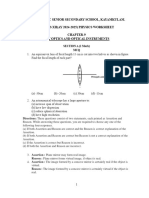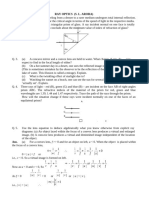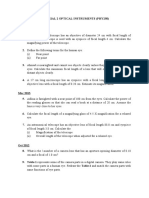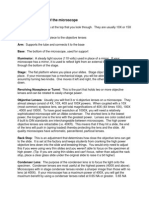0 ratings0% found this document useful (0 votes)
7 views16 Prims & Optical Instruments (Numbercial Problems) - (Sheet - 2)
16 Prims & Optical Instruments (Numbercial Problems) - (Sheet - 2)
Uploaded by
Shabd wadhwa 9cCopyright:
© All Rights Reserved
Available Formats
Download as PDF, TXT or read online from Scribd
16 Prims & Optical Instruments (Numbercial Problems) - (Sheet - 2)
16 Prims & Optical Instruments (Numbercial Problems) - (Sheet - 2)
Uploaded by
Shabd wadhwa 9c0 ratings0% found this document useful (0 votes)
7 views2 pagesOriginal Title
16 Prims & Optical Instruments (Numbercial Problems). (Sheet -2)
Copyright
© © All Rights Reserved
Available Formats
PDF, TXT or read online from Scribd
Share this document
Did you find this document useful?
Is this content inappropriate?
Copyright:
© All Rights Reserved
Available Formats
Download as PDF, TXT or read online from Scribd
Download as pdf or txt
0 ratings0% found this document useful (0 votes)
7 views2 pages16 Prims & Optical Instruments (Numbercial Problems) - (Sheet - 2)
16 Prims & Optical Instruments (Numbercial Problems) - (Sheet - 2)
Uploaded by
Shabd wadhwa 9cCopyright:
© All Rights Reserved
Available Formats
Download as PDF, TXT or read online from Scribd
Download as pdf or txt
You are on page 1of 2
Prism & Optical Instruments (Numerical Problems)
Sheet –
Fun
ics is
Phys
Prism & Optical Instruments
(Numerical Problems)
16. The focal lengths of the eyepiece and the objective of a compound microscope are 5 cm and
1 cm respectively and the length of the tube is 20 cm. Calculate the magnifying power of the
microscope, when the final image is formed at infinity. The value of least distance of distinct
vision is 25 cm. [Ans. 70]
17. (i) Draw a labelled ray diagram of a compound microscope, showing the formation of image
at the near point of the eye. (ii) A compound microscope uses an objective lens of focal
length 4 cm and eyelens of focal length 10 cm. An object is placed at 6 cm from the objective
lens.
(a) Calculate magnifying power of the compound microscope, if the final image is formed at
the near point.
(b) Calculate the length of the compound microscope also. [Ans. 7, 19.14 cm]
18. You are given two converging lenses of focall engths 1.25 cm and 5 cm to design a compound
microscope. If it is desired to have a magnification of 30, find out separation between the
objective and the eyepiece. [Ans. 6.25 cm]
19. The total magnification produced by a compound microscope is 20, while that produced by
the eyepiece along is 5. When the microscope is focussed on a certain object, the distance
between objective and eyepiece is 14 cm. Find the focal length of objective and eyepiece, if
distance of distinct vision is 20 cm. [Ans. 5 cm, 2 cm]
20. The focal lengths of the objective and eyepiece of a microscope are 1.25 cm and 5 cm
respectively. Find the position of the object relative to the objective in order to obtain an
angular magnification of 30 in normal adjustment. [Ans. -1.46 cm]
21. The focal lengths of the objective and the eyepiece of a compound microscope are 1.0 cm
and 5.0 cm respectively. An object, placed at a distance of 1.1 cm from the objective has its
final image formed at (i) infinity, (ii) least distance of distinct vision. Find the magnifying
power and the distance between the lenses. Least distance of distinct vision is 25 cm.
[Ans. 16 cm, -50 ]
22. The focal-lengths of the objects and the eyepiece of an astronomical telescope are 140 cm
and 5.0 cm respectively. Find the magnifying power of the telescope for viewing distant
objects when (a) the final image is formed at the least distance of distinct vision ( 25 cm), (b)
the telescope is in normal adjustment ( that is, the final image is formed at infinity). (c) What
is the separation between the objective and the eyepeice in case (b)? [Ans. -33.6, -28, 145 cm]
23. The focal-lengths of the objective and the eyepiece of a telescope are 50 cm and 5 cm
respectively. Least distance of distinct vision is 25 cm. The telescope is focussed for distinct
vision on a scale placed at a distance of 200 cm away from the objective. Calculate : (a)
separation between the objective and the eyepiece, (b) magnification. [Ans. 70.83 cm-2]
24. A telescope has an objective of focal length 30 cm and an eye piece of focal length 3.0 cm. It
is focussed on a scale distnace 2.0 meter. For seeing with relaxed eye, calculate the separation
between the objective and the eypeice. [Ans. 38.3 cm]
25. The magnifying power of an astronomical telescope in normal adjustment is 100. The distance
between the objective and the eyepiece is 101 cm. Calculate the focal lengths of the objective
and the eyepiece. [Ans. 100 cm, 1.0 cm]
3 Compiled by : Nikhil Saxena 9411916889
Prism & Optical Instruments (Numerical Problems)
26. In a compound microscope, the objective and eye-piece have focal lengths of 0.95 cm and 5
cm respectively and are kept at a distance of 20 cm. The last image is formed at a distance of
25 cm from the eye-piece. Calculate the position of the object and the total magnification.
95
[Ans. - cm, -94]
94
27. You are given following three lenses. Which two lenses will you use an eyepiece and objective
to construct an astronomical telescope?
Lens Power (P) Aperature (A)
L1 3D 8 cm
L2 6D 1 cm
L3 10 D 1 cm.
28. Four double convex lenses, with the following specifications are available :
Lens Focal length Aperture
A 100 cm 10 cm
B 100 cm 5 cm
C 10 cm 2 cm
D 5 cm 2 cm
Which two of the given four lenses, should be selected as the objective and eyepiece to
construct and astronomical telescope and why? What will be the magnifying power and
nomal length of the telescope tube so constructed? Write the advantages of reflecting type
telescope over such a telescope.
OR
Which two of the above four lenses should be selected as objective and eyepiece of a
compound microscope and why? How can the magnifying power of such a microscope be
increased? Draw a labelled ray diagram for the image formation in such a microscope.
29. The following data was recorded for values of object distance and the corresponding values
of image distance in the experiment on study of real image formation by a convex lens of
power +5D. One of these observations is incorrect. Identify this observation and give reason
for your choice.
S. No. Object distance (cm) Image distance (cm)
1 25 97
2 30 61
3 35 37
4 45 35
5 50 32
6 55 30
30. A telescope objective of focal length 1m forms a real image of the moon 0.92 cm is diameter.
Calculate the diameter of the moon taking its mean distance from the earth to be 38 × 10 4
km. If the telescope uses an eyepice of 5 cm focal length, what would be the distance between
the two lenses for (i) the final image to be formed at infinity and (ii) the final image (virtual)
at 25 cm from the eye. [Ans. 105 cm, 104.17 cm]
31. A telescope objective has a focal length of 100 cm. When the final image is formed at the
least distance of distinct vision, the distance between the lenses is 105 cm. Calculate the
focal length of the eyepiece and the magnifying power of the telescope. [Ans. 6.25 cm 20]
32. A reflecting type telescope has concave reflector of radius of curvature 120 cm. Calculate the
focal length of eyepiece to secure a magnification of 20. [Ans. 3 cm]
4 Compiled by : Nikhil Saxena 9411916889
You might also like
- Optical InstrumentDocument4 pagesOptical InstrumentBAAP ka papaNo ratings yet
- Chapter 9 Ray Optics and Optical InstrumentsDocument3 pagesChapter 9 Ray Optics and Optical Instrumentshitharesmi07No ratings yet
- Adobe Scan 04-Oct-2024Document5 pagesAdobe Scan 04-Oct-2024shubhsrivastava233No ratings yet
- ImportantDocument8 pagesImportantAmbuj SinghNo ratings yet
- OPTICAL INSTRUMENTS bookDocument5 pagesOPTICAL INSTRUMENTS bookSanjeeth David KiranNo ratings yet
- Level 1: Ray Optics and Optical Instruments Revision Work Sheet - 5Document3 pagesLevel 1: Ray Optics and Optical Instruments Revision Work Sheet - 5RaziaNo ratings yet
- Astonomical and Compound NumericalsDocument2 pagesAstonomical and Compound Numericalsharshitkumarsingh27No ratings yet
- 9 - 2024 - RAY OPTICS - ASSIGNMENT - 83 - 84 ( COMPOUND MICROSCOPE ) - PDFDocument4 pages9 - 2024 - RAY OPTICS - ASSIGNMENT - 83 - 84 ( COMPOUND MICROSCOPE ) - PDFrathi.shreyanshi1No ratings yet
- 15 Refraction of Light. (Sheet - 4)Document4 pages15 Refraction of Light. (Sheet - 4)Shabd wadhwa 9cNo ratings yet
- 1.Long answer Type questions-convertedDocument2 pages1.Long answer Type questions-convertedRamit LakhaNo ratings yet
- Geometrical Optics - PYQ Add.Document16 pagesGeometrical Optics - PYQ Add.jitu.201194No ratings yet
- Selfstudys Com FileDocument16 pagesSelfstudys Com FileRudra Pratap SinghNo ratings yet
- PDF Mat 17 Optical InstrumentsDocument1 pagePDF Mat 17 Optical Instrumentssohammaity43No ratings yet
- Assimment of Physics Part 2Document1 pageAssimment of Physics Part 2Mohina DasguptaNo ratings yet
- Light Board QuestionsDocument5 pagesLight Board Questionsafraz.arshiNo ratings yet
- Optical Instrument (Numerical)Document5 pagesOptical Instrument (Numerical)navrosepreetsingh8a4hhps14No ratings yet
- Extra Questions - Refraction - Lens - Answers - 230610 - 042208Document5 pagesExtra Questions - Refraction - Lens - Answers - 230610 - 042208Zoha AzizNo ratings yet
- 9 - 2024 - RAY OPTICS - ASSIGNMENT - 85 - 86 ( TELESCOPE )Document4 pages9 - 2024 - RAY OPTICS - ASSIGNMENT - 85 - 86 ( TELESCOPE )rathi.shreyanshi1No ratings yet
- Light Worksheet HHWDocument4 pagesLight Worksheet HHWananyaanish19No ratings yet
- X - Science - Physics - CH-9 Light - Assignment-3Document1 pageX - Science - Physics - CH-9 Light - Assignment-3Shweta DuhanNo ratings yet
- Worksheet 4Document2 pagesWorksheet 4Anagha Krishna KumarNo ratings yet
- ISC Board Questions On Ray Optics Grade 12Document6 pagesISC Board Questions On Ray Optics Grade 12iraNo ratings yet
- Class-10 Reflection and RefractionDocument17 pagesClass-10 Reflection and RefractionKuldeep SinghNo ratings yet
- PHY250 - Tutorial 2.3 (Compound Microscopes, Telescopes)Document2 pagesPHY250 - Tutorial 2.3 (Compound Microscopes, Telescopes)Amar ArbainNo ratings yet
- Optical InstrumentDocument2 pagesOptical Instrumentgcjc,gjc,gjNo ratings yet
- Phys ExerciseDocument32 pagesPhys ExerciseJay Bwoy Ug100% (1)
- Assignment 3 - RefractionDocument4 pagesAssignment 3 - RefractionoshnamittalschoolNo ratings yet
- OPTICAL INSTRUMENTS TestDocument2 pagesOPTICAL INSTRUMENTS TestBee PNo ratings yet
- Ray OptikDocument3 pagesRay OptikgoatvijayfrNo ratings yet
- DOC-20240822-WA0011.Document6 pagesDOC-20240822-WA0011.afraz.arshiNo ratings yet
- Optics Numericals - 33068016 - 2024 - 09 - 29 - 10 - 42Document5 pagesOptics Numericals - 33068016 - 2024 - 09 - 29 - 10 - 42A New Way of learningNo ratings yet
- Numericals Lens FormulaDocument1 pageNumericals Lens Formulamukeshsgf5No ratings yet
- 5+mark+questions +CBSE+X +light +25 12 2019 PDFDocument45 pages5+mark+questions +CBSE+X +light +25 12 2019 PDFPiyushNo ratings yet
- Ray Optics 4Document2 pagesRay Optics 4AryaNo ratings yet
- Light-Practice SheetDocument4 pagesLight-Practice Sheetyash.sharmamsiNo ratings yet
- 10th Periodic Test 1 - RevisionDocument2 pages10th Periodic Test 1 - Revisionop1234gamerNo ratings yet
- Class - 10 - Light - NumericalsDocument6 pagesClass - 10 - Light - Numericalsray67% (6)
- Phy12HL Optical Instruments Worksheet & Problem Set 1 Page 1 of 2Document2 pagesPhy12HL Optical Instruments Worksheet & Problem Set 1 Page 1 of 2dandilopezNo ratings yet
- Adobe Scan 11 Sept 2024 (1)Document2 pagesAdobe Scan 11 Sept 2024 (1)bloggingtipshindi4No ratings yet
- DOC-20241101-WA0012.Document5 pagesDOC-20241101-WA0012.Harshit LodwalNo ratings yet
- Part - IV Class - XII Physics Chapter - : 9 Ray Optics and Optical InstrumentsDocument2 pagesPart - IV Class - XII Physics Chapter - : 9 Ray Optics and Optical Instrumentsroyalrajoria4912No ratings yet
- Exercise 22Document4 pagesExercise 22Nafa HashimNo ratings yet
- Worksheet - Class 10th ScienceDocument5 pagesWorksheet - Class 10th Sciencekaniga127No ratings yet
- 5 (D)Document7 pages5 (D)78kapiNo ratings yet
- Light_ Reflection and RarefactionDocument4 pagesLight_ Reflection and RarefactionitsmekeshavmongiaNo ratings yet
- HOTS On Reflection of LightDocument2 pagesHOTS On Reflection of Lightswadhin100% (4)
- Ray optics WS QSTNS HISDocument5 pagesRay optics WS QSTNS HISkushalNo ratings yet
- Adobe Scan 12-Dec-2024 (2)Document2 pagesAdobe Scan 12-Dec-2024 (2)kirubadithacsNo ratings yet
- LIGHT-PAST PAPER QnsDocument6 pagesLIGHT-PAST PAPER QnsARSHAD JAMIL100% (1)
- Physics XII CH 9 CASE STUDY Ray Optics and Optical InstrumentsDocument15 pagesPhysics XII CH 9 CASE STUDY Ray Optics and Optical InstrumentsNjan KL16么PorottaNo ratings yet
- Ray Optice New MaximumDocument14 pagesRay Optice New Maximumcyberarmy2502No ratings yet
- 12 Ray OpticsDocument12 pages12 Ray Opticsankitteddy94No ratings yet
- TUTORIAL 2 Phy250Document7 pagesTUTORIAL 2 Phy250adriana dahliaNo ratings yet
- CBSE Class 12 Physics Important Questions Only (3 Marks) of OPTICSDocument4 pagesCBSE Class 12 Physics Important Questions Only (3 Marks) of OPTICSPramit RanjanNo ratings yet
- Ilovepdf Merged PDFDocument48 pagesIlovepdf Merged PDFSomik JainNo ratings yet
- Light - Reflection and Refraction Part 2Document7 pagesLight - Reflection and Refraction Part 2Saji JayarajNo ratings yet
- Phy - Light Test Revised 2Document2 pagesPhy - Light Test Revised 2ishaanmoharir2No ratings yet
- DPP 1 Light 2023Document10 pagesDPP 1 Light 2023kaushalgomziNo ratings yet
- Light QuestionsDocument2 pagesLight Questionsilyas aliNo ratings yet
- Optics and Optical Instruments: An IntroductionFrom EverandOptics and Optical Instruments: An IntroductionRating: 4 out of 5 stars4/5 (5)
- Certificado Módulos - LongiDocument16 pagesCertificado Módulos - LongiluverygNo ratings yet
- Ongoing ProjectsDocument1 pageOngoing ProjectsBharat VaishnavNo ratings yet
- HFLD Literature ReviewDocument5 pagesHFLD Literature ReviewMuhammad AamirNo ratings yet
- Physics: Practice Worksheet (HHW)Document4 pagesPhysics: Practice Worksheet (HHW)Anil BhattNo ratings yet
- QL Design 122 18L Spec Sheet 1984Document2 pagesQL Design 122 18L Spec Sheet 1984Alan MastersNo ratings yet
- SIMPLE AND COMPOUND MICROSCOPEDocument22 pagesSIMPLE AND COMPOUND MICROSCOPEkhushkothari16No ratings yet
- Activity 1 The MicroscopeDocument7 pagesActivity 1 The MicroscopeJerome JanNo ratings yet
- Manual de Instruções Nikon Nikkor AF-P DX 18-55mm F - 3.5-5.6G (Português - 2 Páginas)Document3 pagesManual de Instruções Nikon Nikkor AF-P DX 18-55mm F - 3.5-5.6G (Português - 2 Páginas)Anderson LeonardoNo ratings yet
- Synergy - Nano-Tera 2016Document37 pagesSynergy - Nano-Tera 2016nanoteraCHNo ratings yet
- Butterfly Wings & Solar PanelsDocument3 pagesButterfly Wings & Solar Panelsneyashirochan100% (1)
- Datasheet For LED 50340RDocument2 pagesDatasheet For LED 50340RonehourNo ratings yet
- MicroscopeDocument4 pagesMicroscopeZylla Athea TumamposNo ratings yet
- Fenstech CatalogueDocument16 pagesFenstech Cataloguezr.inelectricalsNo ratings yet
- Omega Lighting L6001-L6002 TW & TWD INC A-Lamp Lensed Downlight Spec Sheet 9-85Document2 pagesOmega Lighting L6001-L6002 TW & TWD INC A-Lamp Lensed Downlight Spec Sheet 9-85Alan MastersNo ratings yet
- Lecture 6Document16 pagesLecture 6shivani lohiaNo ratings yet
- Tugas (Pokok Bahasan 6)Document1 pageTugas (Pokok Bahasan 6)Ferdi PratamaNo ratings yet
- CAP-1901-EM-05 - 4 - Cable Routing-1Document2 pagesCAP-1901-EM-05 - 4 - Cable Routing-1Nindy FebrianiNo ratings yet
- Front Elevation Side Section: Skala 1: 25 Window 1Document1 pageFront Elevation Side Section: Skala 1: 25 Window 1Meylan SariNo ratings yet
- Mamiya 645 System: BodysDocument8 pagesMamiya 645 System: Bodysperkinsc305No ratings yet
- Colimacão TelescopioDocument2 pagesColimacão TelescopioFelipe FelixNo ratings yet
- Solar All in One Streetlights 1539760131Document9 pagesSolar All in One Streetlights 1539760131Mayur HiwarkarNo ratings yet
- Curved MirrorsDocument7 pagesCurved MirrorsRhain Congayo100% (1)
- Image Formed by Lenses WorksheetDocument5 pagesImage Formed by Lenses WorksheetMelgeri Aubrey E. UngosNo ratings yet
- Elementary Optics Appliction To FCSDocument226 pagesElementary Optics Appliction To FCSlcnblzr3877No ratings yet
- 1 2 3 4 5 6 7 8 9 10 Lems Isb 17000 11 28.12.12 12 PAN 28.12.12 13 Flash 28.12.12 14 15 16Document3 pages1 2 3 4 5 6 7 8 9 10 Lems Isb 17000 11 28.12.12 12 PAN 28.12.12 13 Flash 28.12.12 14 15 16Sh Mati ElahiNo ratings yet
- CBSE Class 10 Light Reflection and Refraction Study NotesDocument19 pagesCBSE Class 10 Light Reflection and Refraction Study NotesKanchana Sriramulu100% (6)
- Mod 3Document3 pagesMod 3Kevin ArnaizNo ratings yet
- Parts and Function of The MicroscopeDocument3 pagesParts and Function of The MicroscopeStephen GutierrezNo ratings yet
- ASphericDocument5 pagesASpherickndprasad01No ratings yet
- Microscope QuizDocument1 pageMicroscope QuizFaith Joy Peñarejo QuiverNo ratings yet

























































































